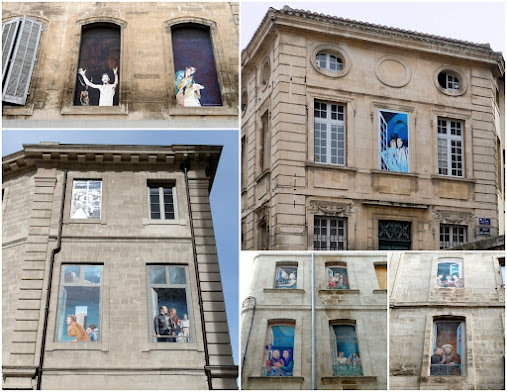The Remarkable Home of 14th-Century Popes:
Visit the monumental palace, once the seat of seven popes, and explore its medieval city. Avignon, a UNESCO World Heritage Site, is known as the “City of Popes” because the papacy was relocated here from Rome, to great controversy, from 1309 to 1377. With a local guide, follow the historic center of narrow streets to the Place de l’Horloge, the city’s central square, a scene of balconies, elegant facades and shading trees. Continue to the renowned Palace of the Popes for a guided tour. This fortress-church—the Middle Ages’ largest Gothic building—is gigantic, dwarfing even the neighboring cathedral. After, continue to the Market Hall for an opportunity to taste olives and pickled garlic. Note: The visit to the Palace of the Popes features many stairs.
Tim and I have been enjoying a quiet breakfast each morning in the Aquavit Terrace, which features a continental breakfast buffet. It’s been a nice respite from the hubbub in the Restaurant, where most passengers eat every meal. I’m still enjoying croissants, and I can fix myself a cappuccino at the coffee station.
Yesterday evening, our ship cast off from Arles and returned to Avignon, where we spent today. On river cruises, Viking typically offers a leisurely shore excursion option for folks who may have walking difficulties. When I read that the tour of the Palace of the Popes included 200 steps, I decided to join them, and Tim tagged along as well. I did not want to aggravate my knee any more than necessary. Our guide was very patient with everyone, and the slower pace also gave me more time for photographs.
We entered Avignon through the old city walls and walked past interesting buildings and expensive shops toward Place de l’Horloge. This square is named for the clock tower that is now hiding behind the more recently built City Hall. Interesting features here include a mosaic depicting Avignon’s coat-of-arms that is embedded in the pavement, a carousel that seems to be a feature of most squares in France, and the beautiful municipal theater.
 |
| Entering Avignon through the City Walls |
 |
| Place de l’Horloge |
We soon arrived at the Palace of the Popes. Although we only viewed it from the outside, our guide explained its history when the entire headquarters of the Roman Catholic Church was moved to Avignon in the 1300s.
 |
| Tim and the Palace of the Popes |
Because we skipped the tour of the Palace of the Popes, we likely had more time than the other tour groups to explore some of the back streets of Avignon. Yes, we were moving more slowly, but we covered quite a lot of ground.
Avignon is known for its trompe l’oeil painted windows, and we saw quite a few on our walk. These windows depict scenes from the Festival d’Avignon and are a tribute to this popular theater celebration. Windows are repainted yearly, and we had fun trying to spot them as we walked.
 |
| Lots of Trompe l’Oeil Painted Windows |
We visited Place St. Pierre, one of the most picturesque little squares in Avignon. The Basilica St. Pierre was built in 1358, and its solid walnut doors feature intricate carvings.
 |
| Place St. Pierre |
Next was a rare fifteenth century building, which was wider on the upper floors due to a medieval loophole that based taxes on the square footage of the ground floor. It seems that tax loopholes are nothing new! We also stopped to see a nineteenth century synagogue, built on the site of a much older one that had been destroyed by fire, reflecting the ancient roots of Jewish culture in Avignon. Last, we passed by Saint-Jean Tower, the only remaining part of a thirteenth century complex.
 |
| Lovely Squares, Passageways, a 15th Century Building, Synagogue, and Saint-Jean Tower |
By this time, we had arrived at Les Halles, Avignon’s modern Market Hall that has acquired the nickname the “Green Wall.” After gazing at the breads, spices, and fish stalls, we were definitely ready for lunch back on the ship.
 |
| Market Hall |

No comments:
Post a Comment